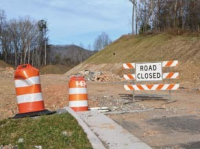A trip back in time: New heritage museum tells the story of Swain’s people, by Swain’s people
 The Smoky Mountain News recently got a sneak peek of the new Swain County Heritage Museum and Visitor’s Center. Leading the tour was David Monteith, who’s been a driving force and visionary behind the museum since its inception.
The Smoky Mountain News recently got a sneak peek of the new Swain County Heritage Museum and Visitor’s Center. Leading the tour was David Monteith, who’s been a driving force and visionary behind the museum since its inception.
While the project has been going full throttle for nearly two years, Monteith’s passion and energy show no sign of letting up as opening day approaches next week.
“This is going to be the people’s story,” Monteith said.
The evolution of the museum mirrors the story of Swain County itself — one of resolve, spirit and small-town pride.
The founding Swain Heritage Museum Board was an all-local, all-volunteer affair, but they weren’t daunted by the prospect of creating a museum from whole cloth. They consciously chose not to hire an outside museum consultant or curator specialist to do it for them.
SEE ALSO: New visitor center to serve as tourist magnet for Swain
Related Items
Instead, they wanted to design their own exhibits, plan their own display lay-out, amass their own collection of artifacts, conduct their own historical research and write all their own signage.
“This is our story of Swain County and we want to tell it,” Monteith said. “We believe we can tell it better than anyone else from the outside.”
Professional curators may start with the story to be told, and round up relics that depict it. But with Swain’s heritage museum, it was partly the other way around.
The heritage board put out a call for donations, and community members stepped up gladly with family heirlooms and photos. The response was overwhelming.
“We are still gathering a lot of stuff I wasn’t even aware was out there,” said Elise Bryson, chair of the Heritage Museum Board.
The exhibits and displays evolved organically as the collection took shape.
“We had to figure out what we had and where it was going to be able to go,” said David Gunner, a member of the heritage board.
The donation of an old log cabin, for example, formed a centerpiece of the museum, rounded out with donations of a pot belly stove and other old-timey furnishings.
When a donation of an 1887 church organ from Forney Creek along with two old salvaged pews came along, it gave rise to an exhibit portraying the importance of churches in the fabric of daily life.
“Churches and schools were very important in the community. Everything revolved around the church. All the socials and community events were held there. The church was usually the school house, too,” Bryson said.
Donations of old farm equipment, tools and household implements — from butter churns to a pedal-powered sewing machine to crockery — depict what life was like for early Appalachian people.
A grassroots affair
Members of the heritage board often reached out personally to old-timers and those known to have deep family roots in Swain. When Virginia DeBord got a call like this from Monteith, she mused on it a while and eventually recalled an old picture of downtown Whittier that had hung on the wall of her husband’s family homeplace.
“I thought that might be a good thing for the museum,” DeBord said. She went and fetched it, and the museum board liked it so much they blew it up to a five-foot poster.
Those who didn’t have “things” to donate pitched in with historic photos. There’s not room for them all in the museum, but they’ve been scanned for posterity and will be used in a rolling slideshow.
The volume of museum pieces flowing in, and the eagerness of so many to be a part of the project, demonstrates just how important heritage is to the people of Swain County. Gunner was among an army of volunteers who picked up artifacts from people who couldn’t bring them in themselves, including an old reap hook and corn sheller from a woman with no way to haul them.
Gunner contributed a slew of his own antiques to the collection, as well.
“I got a gob of my granddaddy’s old blacksmith tools from his blacksmith shop down on Forney’s Creek. I didn’t donate it to them, but I loaned it to the museum as long as they want it,” Gunner quipped.
Some pieces that came in are just plain interesting, even if there’s no universal theme to tie them to. Take for instance an old telephone operator switchboard from the 1920s, likely the first ever in the county, with plugs for the jail, doctor and sheriff still clear as day. Or a 1905 safe from Bryson City Bank, removed from the inside wall of Cork and Bean restaurant during recent remodeling.
While many exhibits took root based on what came in, some were planned out to ensure a comprehensive picture of the county’s history was captured.
“We asked everybody for ideas of ‘What would you like to see in the museum?’” Monteith said.
Exhibits were crafted around the major influences in Swain’s history, like the once-powerhouse industries of logging and mining that created Swain’s first cash economy in the early 1900s, or the construction of Fontana Dam during World War II.
And yet other exhibits showcase local figures, from the famed writer and national park advocate Horace Kephart to the owner of a mainstay downtown café who got his start serving meals from a horse-drawn chuck wagon.
County Manager Kevin King has spent untold hours overseeing the museum, from managing the flow of construction work to honing a little-known talent as an interior decorator.
When the county had to come up with a design for display cases, it was King who thought of a cheap but thematic idea to cover plywood with burlap as a backing. A carpenter in the county’s maintenance department then built glass frames out of reclaimed barn wood to bolt down over them.
One of King’s favorite sections, however, is the kids’ area of the museum. A father of three — ranging from ages 6 to 11 — he didn’t have to look far for inspiration. It’s full of hands-on, interactive exhibits appealing to a variety of ages.
“At the end of the day, you want people to stay longer, and so if the kids are happy, they’ll stay longer,” King said.
On a shoestring
Even the massive restoration job of the century-old historic courthouse was done by local people. Rather than bid the job out to a general contractor, who would no doubt bring in out-of-town laborers, the county used its own in-house maintenance employees. They pooled their trades and crafts as carpenters, masons and builders to carry out the restoration on the clock with the county. King estimates 90 percent of the work was done in-house.
It was a huge undertaking, considering the historic courtroom hadn’t been in use for 40 years.
“The first time I walked in up here I could have cried. You could look through the cracks in the wall and see the outside,” Bryson said.
The renovations were accomplished on a lean budget. The massive remodeling job of the courthouse, site work including a new parking lot, and construction and installation of the museum exhibits cost less than $800,000. The project is funded entirely through revenue from the county’s tourism tax on overnight lodging and grants.
“There’s not a penny of local tax dollars in this,” Monteith said.
But that’s just a small part of what the county can be proud of.
“It just tickles me to death. I want people to see our history and what went on in Swain County,” Gunner said.









